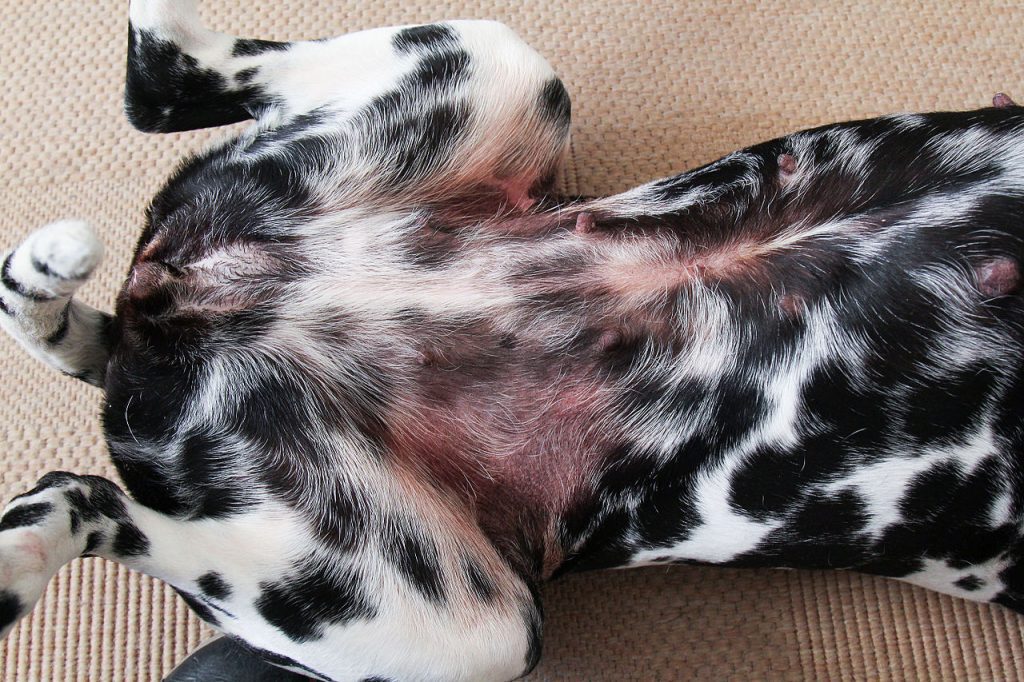If you’ve recently noticed black spots on your dog’s belly, you may be wondering what they could mean.
While it’s important to take your pet to the vet for a proper diagnosis, there are a few things that can cause black spots on dogs’ bellies.
In this blog post, we will discuss some of the most common causes of black spots on dogs’ bellies, as well as what you can do to help your pet feel better.
Key Takeaway
- Black spots on a dog’s belly can be caused by various factors including exposure to the sun, ageing, inflammation, hormonal changes, parasites, seborrhoea, yeast infections, hyperpigmentation, or even certain types of cancer such as melanoma.
- Signs of hyperpigmentation in dogs include discoloration of the skin ranging from light brown to black, thickening or velvety texture of the skin, redness around affected areas, changes in the skin such as hair loss and odor, and in some cases, it may be accompanied by alopecia (hair loss).
- Signs of freckles in dogs include small, flat, light to dark spots that appear on the skin’s surface, often becoming more prominent with age or sun exposure, and commonly appearing on areas like the belly and ear tips; they can also manifest as increased pigmentation of the iris in the eyes.
- Signs of melanomas in dogs include dark-colored lumps or lesions on the mouth, tongue, lips, gums, or skin that may bleed or ulcerate as they grow, facial swelling, foul breath, weight loss despite a good appetite, lethargy, and abnormal pain such as limping.
Why Are There Black Spots on My Dog’s Belly?

Black spots on male and female dog’s bellies can appear for many reasons including hyper-pigmentation where the skin produces too much melanin which results in dark spots on the belly, the black spots could actually be freckles which occur in dogs with fair skin who spend a lot of time outdoors, or the black spots could be melanomas, which are growths that develop from pigment-producing cells called melanocytes.
1. Hyper-pigmentation
Hyper-pigmentation in dogs is a darkening of the skin. It can be caused by many things, including sun exposure, trauma, or allergies. Hyper-pigmentation is not harmful to dogs and usually goes away on its own.
Hyper-pigmentation is a condition where the skin produces too much melanin, resulting in dark spots on a dog’s belly. This can be caused by a number of things, including genetics, injury, or disease. Hyper-pigmentation is not harmful to dogs and does not need to be treated unless it is causing your dog discomfort.
There are several ways that you can help prevent hyper-pigmentation in your dog. First, avoid exposing your dog to the sun for long periods of time. If you must take your dog outside during the day, make sure to put sunscreen on them. Second, if your dog has any allergies, try to avoid triggering them. Third, if your dog has any wounds or injuries, make sure to clean and treat them properly.
Hyper-pigmentation in dogs is a harmless condition, but it can be unsightly. By taking some simple precautions, you can help prevent it from happening. If you have any concerns, talk to your veterinarian. They will be able to give you more specific advice on how to care for your dog.
2. Freckles
Freckles are small, brown, or black spots on the skin. They’re usually round and they can occur in any area of the body that has hair, including the dog’s belly. Freckles are caused by a build-up of melanin, which is the pigment that gives color to the skin, hair, and eyes. Dogs with freckles generally have lighter-colored fur, and they may also have lighter-colored noses and lips.
Freckles are more common in certain breeds of dogs, including Australian Cattle Dogs, Beagles, Boston Terriers, Boxers, Bulldogs, Dalmatians, Dachshunds, English Springer Spaniels, Golden Retrievers, Labrador Retrievers, Lhasa Apsos, Maltese, Miniature Poodles, Scottish Terriers, Shih Tzus, West Highland White Terriers, and Yorkshire Terriers.
Some of these breeds are more likely to have freckles because they have less pigment on their skin.
While freckles are generally harmless, some dogs may develop a condition called solar dermatitis, which is caused by exposure to the sun. Solar dermatitis can cause the freckles to become raised and irritated. If your dog has solar dermatitis, you should talk to your veterinarian about treatment options.
3. Melanomas
Melanoma in dogs is cancer that develops in the cells that produce melanin. Melanin is the pigment that gives color to the skin, hair, and eyes.
It can occur in any breed of dog but is most common in breeds with dark coats, such as poodles and Labrador retrievers. Melanoma usually appears as a black or brown growth on the dog’s belly, although it can also occur in the mouth, anus, or genital area.
There are two main types of melanoma: cutaneous (skin) and ocular (eye). Cutaneous melanomas are by far the most common type of melanoma in dogs. They typically appear as dark-colored bumps on the skin, although they can also occur as flat lesions.
Ocular melanomas are much less common, but they can be very aggressive and often metastasize (spread) to other parts of the body.
There are several possible causes of melanoma in dogs, including exposure to ultraviolet (UV) light from the sun, certain chemicals, or viruses. However, the exact cause is unknown.
Treatment for melanoma in dogs depends on the type, location, and stage of cancer. Surgery is usually the first line of treatment for cutaneous melanomas.
Ocular melanomas are more difficult to treat and may require radiation therapy or chemotherapy. Metastatic melanomas are generally not curable and may require palliative care to control symptoms.
Signs of Hyperpigmentation in Dogs
Hyperpigmentation in dogs is characterized by an increase in the dark pigmentation of the skin, often accompanied by changes such as thickened areas, hair loss, redness, and sometimes odor.
Discoloration of the Skin
One of the most apparent signs of hyperpigmentation in dogs is a change in the color of their skin. The affected areas may turn light brown to black, indicating an increase in the production of melanin, the pigment responsible for the color of the skin.
Changes in Skin Texture
Along with the discoloration, hyperpigmentation often causes changes in the texture of the dog’s skin. This can result in the skin becoming velvety or thickened. These changes are usually localized to the areas where the hyperpigmentation is occurring.
Hair Loss
Hyperpigmentation can also lead to hair loss in the affected areas. This is often due to the inflammation or friction that is causing the hyperpigmentation. The hair loss may be patchy and is typically seen in conjunction with the other symptoms.
Redness and Odor
In some cases, the areas of hyperpigmentation may be surrounded by redness, indicating inflammation. There may also be an odor associated with the affected areas. This is often a sign of secondary hyperpigmentation, which is caused by inflammation or friction.
Other Symptoms
Other symptoms may include itching, pain, or discomfort in the affected areas. These symptoms can vary depending on the underlying cause of the hyperpigmentation. If your dog displays any of these signs, it is important to consult with a veterinarian for proper diagnosis and treatment says Wag Walking.
Signs of Freckles in Dogs
Freckles in dogs, often referred to as ticking, are common spots of pigmentation that can occur naturally with age, sun exposure, or be present from birth in certain breeds.
Appearance of Freckles
Freckles on dogs typically appear as light to dark spots that are flat to the skin surface. They can appear anywhere on the dog’s body but are commonly found on areas exposed to the sun such as the belly and ear tips.
Freckles and Age
Freckles often become more prominent with age. This is a natural process and not usually a cause for concern unless there are sudden changes in the size, color, or number of freckles.
Freckles and Sun Exposure
Just like in humans, dogs can develop sun spots or freckles due to exposure to sunlight. These sunspots are generally harmless but it’s important to provide your dog with shade and consider sun protection if they spend a lot of time outdoors.
Eye Freckles
Eye freckles, or increased pigmentation of the iris, can be a congenital condition or develop over time. While eye freckles themselves are not harmful, any changes in your dog’s eyes should be evaluated by a veterinarian to rule out underlying health conditions.
Breed-Specific Freckles
Certain breeds, like Dalmatians, are known for their freckled appearance. This breed-specific characteristic is part of their genetic makeup and not a symptom of a health issue.
Signs of Melanomas in Dogs
Melanomas in dogs typically present as pigmented masses that can vary in color from black, brown, grey to pink, often causing discomfort, bleeding, or ulceration as they grow and potentially leading to symptoms such as limping, swelling, weight loss, and lethargy.
Pigmented Masses
Melanomas are primarily identified by the presence of a lump or mass on the dog’s body. These masses can range in color from dark shades like black, brown, or grey, but some may also appear pink. They can develop anywhere on the body, including the mouth, tongue, lips, gums, pads of feet, toenail beds, and skin.
Discomfort and Physical Changes
The affected area might show signs of swelling or discharge, particularly if the melanoma is located on a foot, causing the dog to limp. In some cases, there might be bleeding or ulceration as the melanoma grows.
Oral Symptoms
If the melanoma develops in the mouth, it might result in facial swelling, bloody drool, and foul breath. These symptoms usually indicate a serious condition and require immediate veterinary attention.
Weight Loss and Lethargy
Despite maintaining a good appetite, a dog with melanoma might experience unexplained weight loss. Additionally, the dog may act lethargic, showing reduced energy levels and enthusiasm for activities they previously enjoyed.
Changes in Skin and Coat
Skin melanomas might appear as strange-colored lumps or bumps on the skin. They can be pigmented or non-pigmented and can affect any part of the body. Any new or changing lumps should be checked by a veterinarian.
When To Visit The Vet
Visiting a vet is essential when your dog shows any signs of discomfort or changes in their skin condition.
Black Spots Accompanied by Itching
If your dog’s black spots are accompanied by itching, it could be an indication of a skin condition like allergies, dermatitis, or even parasites.
Itching can lead to scratching, which might cause infections if left untreated. It’s advisable to consult your vet to identify the underlying issue and start appropriate treatment.
Changes in Size or Appearance of Spots
Any change in the size, color, or appearance of the spots on your dog’s skin should warrant a visit to the vet.
Changes could signify a skin condition progressing or possibly the development of a more serious issue such as melanoma. Early detection is crucial for effective treatment.
Signs of Discomfort
If your dog shows signs of discomfort, such as limping, restlessness, loss of appetite, or changes in behavior, it’s important to consult with a vet.
These signs could be indicative of various health issues, including those related to the skin. A vet can help determine the cause and advise on the best course of action.
Treatment for Black Spots on a Dog’s Belly
Treatment for black spots on a dog’s belly largely depends on the underlying cause, but common methods include using medicated shampoos, steroid ointments, antifungal treatments, and in some cases, natural remedies like hydrogen peroxide and borax.
Treating Underlying Causes
The primary approach to treating black spots on a dog’s belly is to address the root cause. This could be inflammation, hormonal diseases, or yeast infections. Once the underlying condition is identified and treated, the black spots may diminish or disappear.
Medicated Shampoos and Steroid Ointments
If the black spots are a result of inflammation or hyperpigmentation, early cases might respond to treatment with medicated shampoos and steroid ointments. These treatments can help soothe inflammation and potentially lighten the pigmentation.
Antifungal Treatments
In cases where a yeast infection is causing the black spots, antifungal treatments can be effective. These treatments can be administered topically or orally depending on the severity of the infection.
Natural Remedies
Natural remedies like hydrogen peroxide and borax have been known to help treat black spots on dogs. However, it’s important to note that these should be used under the guidance of a vet to ensure they are safe for your pet.
Regular Check-ups
Regular check-ups are crucial to monitor the condition of the black spots and adjust treatments as needed. If the spots change in size, color, or quantity, or if they are accompanied by other symptoms such as itching or discomfort, it’s imperative to consult with a vet immediately.
Preventing Black Spots on a Dog’s Belly
Preventing black spots on a dog’s belly involves regular grooming, maintaining a healthy diet, ensuring proper hygiene, and regular vet check-ups to detect and treat potential issues early.
Regular Grooming
Grooming your dog regularly can help prevent skin conditions that might lead to black spots. Regular brushing keeps their coat clean, reduces the likelihood of skin infections, and provides an opportunity to spot any changes in their skin early.
Healthy Diet
A healthy diet is essential for maintaining your dog’s overall health, including their skin. Foods rich in omega-3 fatty acids can help keep your dog’s skin healthy and less susceptible to conditions that might cause black spots.
Proper Hygiene
Maintaining proper hygiene is key to preventing skin conditions in dogs. Baths with dog-friendly shampoos can help keep the skin clean and free from yeast and bacteria that could cause infections and subsequent black spots.
Regular Vet Check-ups
Regular vet check-ups are crucial to monitor your dog’s health and catch any potential issues early. If your vet notices any changes in your dog’s skin, they can start treatment immediately, potentially preventing the formation of black spots.
Sun Protection
In some cases, black spots can be a result of excessive sun exposure. Providing shade for your dog when they’re outdoors and considering dog-friendly sunscreens can help protect their skin.
Using Natural Remedies
Some natural remedies, like hydrogen peroxide and borax, can help in treating and potentially preventing black spots. However, these should be used under the guidance of a vet to ensure they’re safe for your pet.
FAQs
Q: Are black spots on a dog’s belly always a sign of skin cancer?
A: No, black spots on a dog’s belly are not always a sign of skin cancer. While it is important to have any abnormal skin changes checked by a veterinarian, black spots can have various causes that are not related to cancer. These spots can be harmless and may not require any treatment.
Q: Should I be worried if my dog has black or brown spots on their belly?
A: In most cases, black or brown spots on a dog’s belly are not a cause for concern. However, if the spots are raised, bleeding, or if you notice any other concerning symptoms such as hair loss or skin changes, it is recommended to consult a veterinarian for a proper diagnosis.
Q: Can black spots on a dog’s belly be itchy?
A: Yes, black spots on a dog’s belly can be itchy. Itching can occur if the black spots are caused by skin infections, allergies, or irritations. If your dog is experiencing itching or discomfort, it is important to have them evaluated by a veterinarian to determine the underlying cause and provide appropriate treatment.
Q: What are the common causes of black spots on a dog’s belly?
A: The common causes of black spots on a dog’s belly include hyperpigmentation, skin infections (bacterial or fungal), flea bites, allergic reactions, hormonal imbalances, and certain underlying skin conditions.
Q: Can black spots on a dog’s belly be a sign of a more serious health issue?
A: While black spots on a dog’s belly are generally harmless, they can occasionally indicate an underlying health issue. For example, black spots on the skin can be a symptom of Cushing’s disease, a condition affecting the adrenal glands. It is important to consult a veterinarian if you notice any unusual or concerning symptoms.
Q: Can certain dog breeds be more prone to black spots on their belly?
A: Yes, certain dog breeds may be more prone to developing black spots on their belly. Breeds with darker skin pigmentation, such as Rottweilers, Doberman Pinschers, and Labrador Retrievers, are more commonly affected. However, black spots can occur in dogs of any breed.
Q: How can I prevent black spots from appearing on my dog’s belly?
A: Preventing black spots on a dog’s belly can be challenging as some causes are out of your control. However, you can reduce the risk by regularly inspecting and cleaning your dog’s belly, keeping them protected from fleas and ticks, and maintaining a healthy and balanced diet to support good skin health.
Q: Can I use over-the-counter treatments to remove black spots from my dog’s belly?
A: It is not recommended to use over-the-counter treatments to remove black spots from your dog’s belly without proper veterinary guidance. The treatment approach will depend on the underlying cause of the spots, and a veterinarian will be able to provide the most appropriate and effective treatment for your dog.
Q: When should I take my dog to the vet for black spots on their belly?
A: It is advisable to take your dog to the vet if you notice any concerning symptoms along with the black spots, such as itching, hair loss, bleeding, or swelling, or if the spots appear to be changing in size, shape, or color. A veterinarian can properly evaluate your dog’s condition and recommend the necessary steps for diagnosis and treatment.
Conclusion and final thoughts
Overall, the black spots on your dog’s belly are common and nothing to worry about. They can be caused by a variety of factors such as genetics, skin pigmentation, or allergies.
It is important to regularly check your dog’s skin for any changes or abnormalities and consult with a veterinarian if you have concerns.




